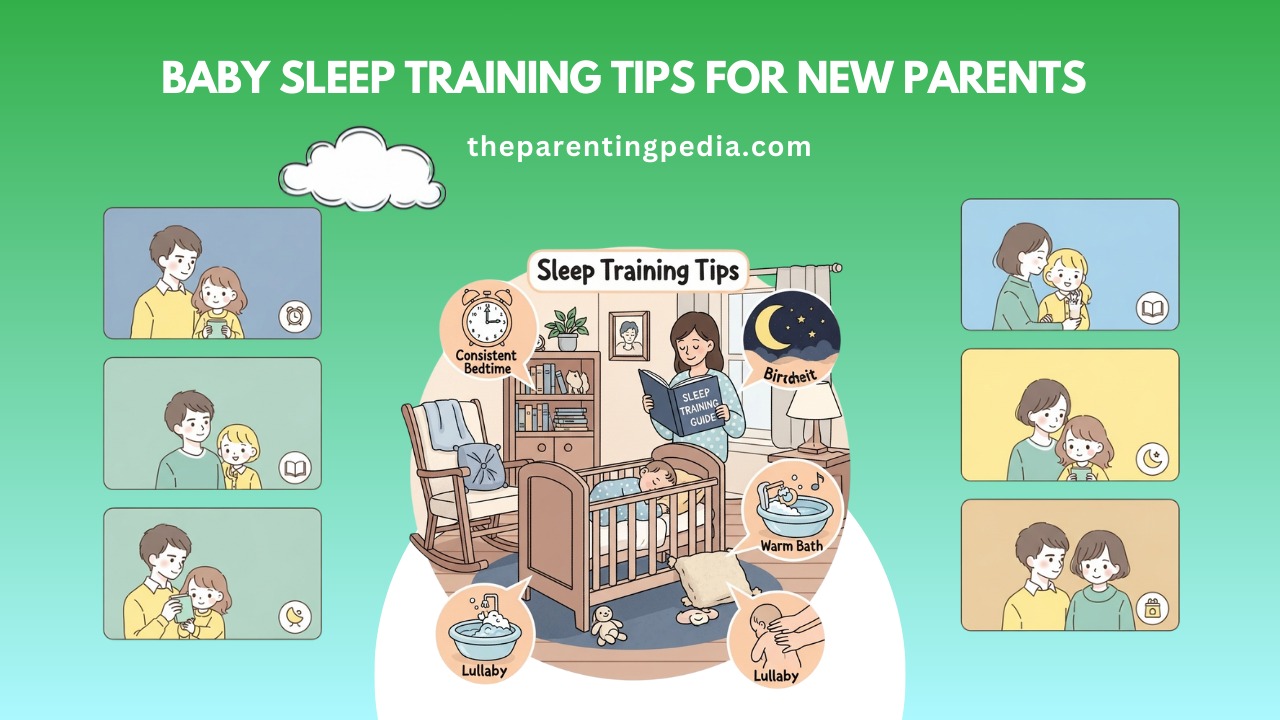Parenting a newborn is a joyful but often exhausting experience. One of the biggest challenges new parents face is helping their baby sleep well. Sleep is essential for both babies and parents, yet many families struggle with irregular sleep patterns. This is where baby sleep training can make a significant difference. By establishing healthy sleep habits early, parents can help their children sleep better and enjoy more restful nights.
Understanding Baby Sleep Training
Baby sleep training is a method used to help infants learn how to fall asleep independently and stay asleep for longer periods. While every baby is different, the goal is to teach babies a consistent sleep routine that promotes healthy rest. Sleep training is not about forcing a baby to sleep harshly, it is about guiding them gently toward better sleep habits while considering their developmental stage and individual needs.

Why Baby Sleep Training Is Important?
Sleep is vital for a baby’s growth, brain development and emotional regulation. Without enough rest, babies can become irritable, fussy and less focused during play or learning, while parents may experience fatigue, stress and reduced patience. Implementing baby sleep training offers benefits such as improved mood and alertness for both baby and parents, better physical and cognitive development, consistent sleep routines that reduce nighttime stress and enhanced parent-child bonding during daytime activities. By helping babies develop healthy sleep patterns, parents support their child’s overall well-being and create a calmer home environment.
Signs a Baby Is Ready for Sleep Training
Before starting baby sleep training, parents should look for signs that their child is ready for it. While most babies are ready between 4 and 6 months, readiness can vary. Signs include sleeping for longer stretches at night naturally, showing consistent nap patterns during the day and demonstrating the ability to calm themselves for short periods. Recognizing these signs helps parents choose the right approach and increases the chances of successful sleep training.
🎯 Participate in Offers and Redeem Your Reward Now
Common Baby Sleep Training Methods
There are several approaches to baby sleep training and parents should choose one that aligns with their comfort level and their baby’s temperament.
1. Gradual Extinction Method
This method involves letting the baby cry for short, gradually increasing periods before offering comfort. It teaches babies to fall asleep on their own while still receiving reassurance at intervals. Parents can check on their baby at set times, such as every 5, 10 and 15 minutes and then gradually extend the wait. The goal is to help the child learn to self-soothe and fall asleep on their own, gradually increasing the time between parental check-ins until the child can sleep independently.
2. No Tears Method
This gentle approach emphasizes comforting the baby until they fall asleep. Parents might rock, sing or soothe their baby in their arms. Over time, the baby learns to fall asleep with less direct help. This method is suitable for parents who prefer minimal crying during sleep training.
3. Pick Up/Put Down Method
In this method, parents pick up the baby to comfort them when they cry but put them back in the crib while still awake. The baby gradually learns to self-soothe while still feeling supported. This method balances gentle reassurance with teaching independence.
Share smarter, not harder! 🔗 Upload any image & get a quick link you can post anywhere 🌍 https://imagelink.online
4. Chair Method
Parents sit next to the baby’s crib and offer reassurance without picking them up. Over several nights, the parent gradually moves the chair farther away until the baby can fall asleep independently. This method combines proximity and gradual independence.
Tips for Successful Baby Sleep Training
1. Establish a Consistent Bedtime Routine
A predictable bedtime routine helps babies recognize sleep cues and signals that it is time to rest. Activities like a warm bath, gentle massage, reading a story or soft music create a calming environment. Consistency strengthens the effectiveness of baby sleep training.
2. Create a Comfortable Sleep Environment
The sleep space should be quiet, dark and comfortable. Consider using blackout curtains or a comfortable crib mattress. A consistent environment signals to the baby that it is time to sleep and reinforces baby sleep training efforts.
3. Pay Attention to Wake Windows
A wake window is the amount of time a baby or toddler can stay awake between naps or night time sleep without becoming overtired. Understanding how long a baby can stay awake before becoming overtired is important. Babies who are too tired may struggle to fall asleep. Following age-appropriate wake windows supports successful baby sleep training.
Also Read: The Influence Of Extended Family On Raising Children
4. Encourage Self-Soothing
Self-soothing is the ability to fall asleep independently. Parents can promote this by placing the baby in the crib while drowsy but still awake. Gradually, the baby learns to soothe themselves without constant help which is a key objective of baby sleep training.
5. Be Consistent
Consistency is one of the most critical factors for successful sleep training. Sudden changes in routines or inconsistent responses to night wakings can confuse the baby and slow progress. Maintaining consistent practices reinforces good sleep habits.
6. Track Progress
Keeping a sleep diary or journal helps parents monitor patterns, note improvements and identify challenges. Tracking progress also provides reassurance and helps adjust strategies if needed.
Video Source: Sleep Training made easy with the Ferber Method by
‘Babies and Bones’. All rights belong to the original creator.
Common Challenges in Baby Sleep Training
Parents may encounter obstacles during baby sleep training, though these challenges are usually temporary. Common issues include short-term increased crying during the first nights, resistance to new routines or changes in the environment, disruptions from illness or teething and parental fatigue or stress that can make consistency difficult. It is important for parents to remain patient, flexible and compassionate throughout the process, remembering that sleep training is a gradual learning experience for both the baby and themselves.
Tips for Parents During Sleep Training
- Take Care of Yourself – Sleep training can be exhausting, so parents should rest when possible and share responsibilities.
- Stay Positive and Patient – Celebrate small successes and progress, even if it takes several weeks to see full results.
- Avoid Comparing – Each baby is unique and progress may vary. Consistency with chosen method of parents matters more than comparisons.
- Communicate with Partners – Agree on routines and strategies with your partner to maintain consistency.

Conclusion
Baby sleep training is a valuable tool for new parents seeking better sleep for themselves and their child. By establishing clear routines, encouraging self-soothing and using consistent strategies, parents can help their baby develop healthy sleep habits that last. Though challenges may arise, patience, consistency and love are key. With the right approach, baby sleep training benefits not only the baby’s physical and emotional health but also the well-being of the entire family.
Remember, there is no single perfect method, the best approach is one that suits the baby’s temperament and the family’s lifestyle. Over time, parents will see improvements in their baby’s sleep patterns and nights at home will become calmer and more renewing for everyone. By understanding and practicing baby sleep training, parents lay the foundation for a lifetime of healthy sleep habits, emotional resilience and a happier, more rested family.
FAQ
How to sleep train a difficult baby?
To sleep train a difficult baby, parents should stay consistent with routines, offer comfort while encouraging self-soothing and create a calm sleep environment. Gradually implement gentle methods, such as the pick-up/put-down or no-cry approach and track progress. Patience, flexibility and understanding the baby’s needs are key to success.
What is the most gentle sleep training method?
The most gentle sleep training method is the no-cry approach, where parents soothe the baby to sleep without letting them cry for extended periods. It involves rocking, feeding or comforting, gradually reducing assistance over time. This method promotes self-soothing while minimizing stress for both baby and parents.
What is the 5 3 3 rule for babies?
What is the 5-3-3 rule for baby sleep? The 5-3-3 rule is a loose guideline for structuring a baby’s sleep schedule: 5 hours of wake time before the first nap, 3 hours of wake time before the second nap, and 3 hours before bedtime
What is respectful sleep training?
Respectful sleep training involves creating a secure attachment with your child, responding to their cues, and helping guide them back to sleep. Because of this, this method takes longer and typically requires more time and commitment from the parents.
What do psychologists say about sleep training?
Overall, there is good evidence that sleep training methods can improve parental mood disorders, or change (parental reports of their) babies’ sleep patterns in the short term. Evidence that sleep training actually helps babies to sleep better or longer is scarce.
How do I know if baby is overtired?
Signs an infant is overtired include excessive crying and fussiness, clinging and irritability, rubbing eyes or pulling ears, and hyperactivity, which is a paradoxical burst of energy. They may also yawn more, resist sleep, have shorter or more fragmented naps, and become more clumsy. Identifying these cues can help you provide your baby with the sleep they need to avoid a cycle of overtiredness.
Discover 20 proven online business ideas that anyone can start today.
Credits / References:
We do not own the video content shared in this article. Credit goes to the original creator, Babies and Bones, on YouTube. Embedded here under YouTube’s standard embed policy.
